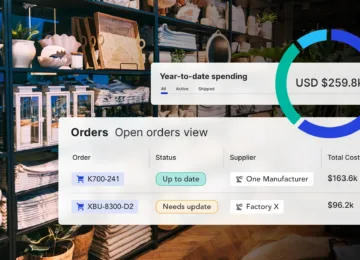Supply chain efficiency can make or break a business. That’s why managers place so much focus and effort on making sure everything is optimized from building your inventory to getting your product to the customer’s door.
But, what about after the customer has your product? Unfortunately, your job isn’t quite done yet, thanks to your customer’s favorite feature and most supply chain managers’ worst nightmare: returns.
It’s the antithesis of the holiday season: the post-sales rush of processing returns and dusting off your reverse supply chain handbook. Far too many businesses fail to take into account the cost and logistics of returns when looking at their expenses. The reverse supply chain is a giant what if that managers take as an afterthought, and it’s creating a huge burden for companies.
The Financial Impact of Returns Is Over $60 Billion Annually
Customers love having the option of a free return policy almost as much as free shipping. It gives them security, a guarantee when shopping—a backout plan that gives them ease. More and more businesses are offering lenient return policies to remain attractive to customers, but what happens when (not if) the customer pulls the trigger and files a return? Now the brand is on the hook for fulfilling their end of the deal, or risk an unhappy customer just waiting to tell the world about their experience.
This is especially hard on businesses during the end of the year holidays. January alone accounts for nearly 24% of all returns for the year. This comes out to nearly $60 billion in lost revenue across all businesses, annually, according to Clear Returns.
Here are some holiday returns stats to consider:
1. Over 30% of sales are usually returned.
2. Over 70% of customers say that a good return experience influences their decision to continue buying from the company.
3. Because businesses often throw away returned items that can’t be easily re-sold, 30% of all returns go straight to a landfill.
4. 67% of shoppers read the return policy before making a purchase (compare that to the zero percent of shoppers who read your site’s user agreement).
Three out of every ten sales is a lot of returns to process. Compound that with the fact that most customers want a “no questions asked” hassle-free return process (be prepared for the angry online reviews, otherwise), and the cost of returns adds up quickly for a business. Remember, it’s not just the return shipping that you have to pay for, but the time and employee labor that has to go into handling the return, restocking/re-inventorying, and determining if the product is re-sellable. And, if it can’t be re-sold, some businesses decide to eat the whole cost of the product and into the garbage it goes. Oftentimes, the cost of a return can be double what it costs to sell in the first place.
How Companies Can Mitigate the Return Nightmare
No, the answer is not to stop offering returns—that’s a great way to ruin your customer relationship. Instead, businesses should be looking at ways to minimize the waste and squeeze out what profit you can from returns. Here are a few options:
1. Utilize your Brick and Mortar. If your company has the option of a brick and mortar storefront, you’re in luck. Not only do customers prefer returning items to a physical location as opposed to the mail option, but it’s also cheaper for you. No shipping fees and fewer logistics means saved time and money.
If you’re looking for ways to minimize return cost and have a physical location, consider bolstering up and streamlining the returns process at your storefront while incentivizing your customers to go that route should they decide to return a product. Bonus points: it gets them back into your store to shop.
On the other hand, if you don’t have a physical store, you’re not out of luck. More and more online brands are partnering with businesses that are willing to provide a space in the real world where customers can make their returns. Companies like Walgreens and Nordstrom are offering up their spaces as pick-up and drop off locations—customers can leave their returns there and FedEx will come by to ship it back to the online retailer. This results in a more attractive return policy that e-commerce sites can offer their patrons plus increased foot traffic for the brick and mortar—an easy win-win for everyone. Other DTC brands offer flexible return policies to lessen the stress of returns in the weeks following the holidays. Offering a 100-day trial versus the typical 30 days deadline can help a brand manage returns over a period of months vs weeks.
2. Innovate to liquidate. In a world where going green matters to your customers, tossing out your returns will be death sentence if word of your wasteful process ever gets out. Just ask Eddie Bauer and Nike.
Even if your returned product is not immediately re-sellable to a customer as if it were new, there are other options to still gain a profit from it. Consider looking at overstock companies or businesses who specialize in selling used goods. Selling your product to them at a discount is infinitely better than simply throwing out what you can’t use. Additionally, having a policy that minimizes waste will improve your company’s image.
Of course, there are more radical ways to re-use your returned goods, such as this Swedish power plant that burns unsold H&M clothing instead of coal, but, maybe look at simpler options first.
3. Get good data. It’s hard to optimize and boost efficiency if you don’t have data and an intelligent supply chain platform. Streamlining your processes and using data to make predictions on how much returns are going to cost can help you optimize your inventory and plan properly for the post-holiday return rush.
Being data-driven can help you analyze and manage your supply chain so you can make informed decisions to prepare your company for the inevitable post-holiday blues. Effective planning starts with information, information starts with data, and data is the source of truth.
Are you Ready?
As the year draws to an end, ask yourself, what is my business doing to absorb the impact of return costs? How much money is our company prepared to spend on returns?
What does your reverse supply chain look like? Let us know in the comments below.



